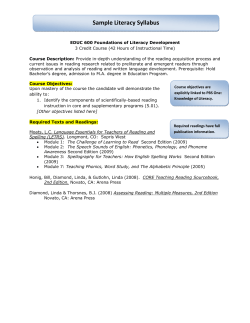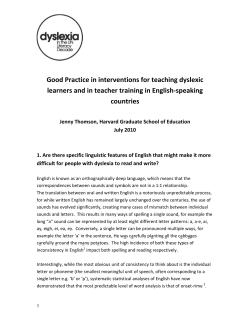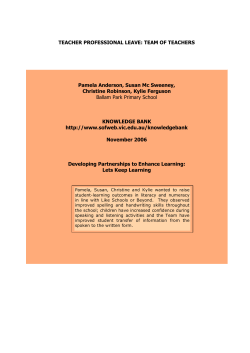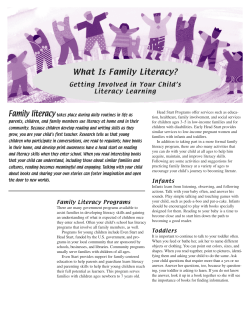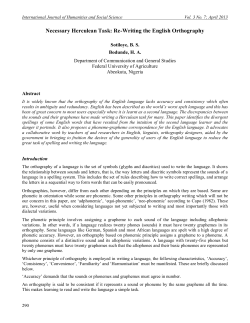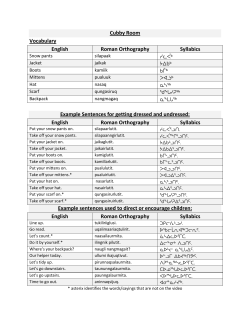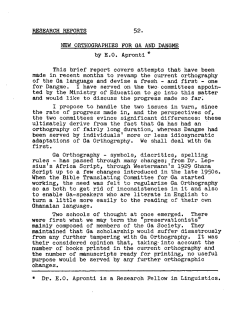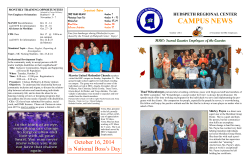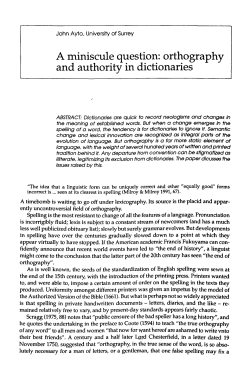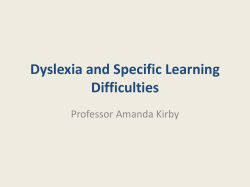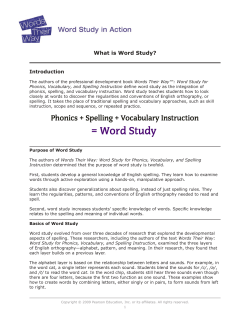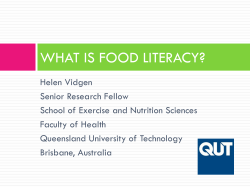
Document 566
77 The Reading Matrix © 2009 Volume 9, Number 1, April 2009 Handbook of Orthography and Literacy R. Malatesha Joshi & P.G. Aaron (Eds.) (2006) Mahwah, NJ: Lawrence Erlbaum Associates Pp. xiv + 802 ISBN: 0-8058-5467-3 Cost: $79.95 Reviewed by Liz Howell The University of Waikato Language Institute The Handbook is an impressive collection of 43 articles on the theory and practice of literacy acquisition (LA) in more than twenty languages, resulting from presentations given in 2002 at the Advanced Study Institute on Orthography and Literacy in Italy. LA includes both learning to read and learning to write, concerns which are ever more important on the 21st century‟s information highway. In their introduction, the editors point out that until the 1980s the English language was the base model for studies of LA. But the Internet has facilitated communication among researchers in global education and refocused studies of literacy by linguists, psychologists, and educators in relation to their own languages. The editors clarify three key terms in the research as follows: 1. writing system: Written language described in terms of linguistic units; for example, morphemic writing (Chinese) … and alphabetic writing (Italian and Spanish); 2. orthography: The visual representation of language…. Examples …are Chinese …and English; 3. script: The graphic format in which writing is represented…[such as] Roman …and Arabic script (p. xiii). Two other important terms in this collection describe the structure of syllables: onset—the initial consonant or consonant cluster and rime—the vowel and any following consonants. According to Treiman in children‟s developing phonemic awareness, syllables and their subunits (onset and rime) are recognized before phonemes (p. 582). The papers by the 71 authors included in this collection are categorised into three sections. Section 1, “Literacy Acquisition in Different Writing Systems,” contains 26 papers on languages, including Arabic, Dutch, Icelandic, Kannada, Kishwahili, Norwegian, Russian, and Turkish. Pind‟s chapter on the evolution of the Icelandic writing system provides a good example of the conceptual thrust of the section as a whole. He compares Icelandic with English (as many of the authors do) and the origin of words which raises issues of synchronic versus diachronic language study and the compromises required in the battle between language history and standardisation (pp. 3-4). Brief mention can only be made of a few other papers in this section: Durgunoglu introduces issues concerning adult literacy for Turks (p. 228). With regard to Russian, Grigorenko points out that a language may be “phonologically transparent” but “orthographically complex” (p. 314). Abu Rabia and Taha explain (p. 321) the difference 78 between vowelized Arabic which is orthographically shallow, whereas unvowelized Arabic is deep. This affirms what students of Arabic know: that unmarked authentic texts such as newspapers are harder to read than beginners‟ texts with diacritical marks. Section 2, “Literacy Acquisition from a Cross-Linguistic Perspective,” contains eight papers on LA from cross-linguistic viewpoints, which provide extremely useful overviews. For example, Seymour provides a useful theoretical framework for beginning reading in different languages; Caravolas describes how she investigated learning to spell (feed forward: spelling to sound versus feedback: sound to spelling) in different languages with alphabetic orthographies; and Goswami discusses reading development in relation to orthography and phonology (p. 469). Section 3, “Literacy Acquisition: Instructional Perspectives,” contains nine papers, all of which provide helpful input for teachers of reading and writing on topics ranging from teaching phonics to mediated learning. A review of one chapter will suffice to show the wealth of information provided in all. Treiman investigates the relationship between knowledge of letters as a basis for young children learning to read and spell in English. She acknowledges that phonemic awareness (PA) is considered a good predictor of reading success, as research has frequently identified, but she affirms that an equally good predictor is knowledge of letters and the sounds they represent, although this has been investigated to a much lesser extent. She, therefore, reviews recent research, including her own, on this knowledge in order to show that “it involves much more than rote memory” and “has important implications for instruction” (p. 583). Treiman describes research into children as young as three learning English in the U.S., Chinese in Hong Kong, and Hebrew in Israel who are able to represent the sounds they hear approximately in their linguistically appropriate visual characteristics (p. 583). She has investigated the importance of a pre-school child‟s first name in acquiring familiarity with the writing system, first as a logograph (following Firth, 1985), then analytically with attention to the phonemes featured in the name. Her research leads her to propose that knowledge of their own names explains children‟s spelling errors just as their PA does, something which instructors will find intriguing. Further research into children‟s knowledge of the names and sounds of letters in the English alphabet has led her to suggest that there are three categories of letters: “those for which the sound is at the beginning of the name (e.g., v), those for which the sound is at the end of the name (e.g., m), and those for which the sound is not in the name at all (e.g., w).” These differences accounted for different levels of success in her study, with children performing best on the first category and worst on the last (p. 588). In other studies Treiman investigated the so-called inconsistency of English as a „deep‟ orthography. She found that children begin to use etymology to work out that pronunciation may differ but spelling stays the same (e.g., heal/health) (p. 595). Her findings show that college students use context to predict which spelling is more likely for a phoneme. Treiman concludes (p. 597) that both knowledge of the alphabet and PA are essential to LA and that children bring their prior experience of print to the formal reading/writing classroom. Key concepts which recur in many of the papers include: 1) The orthographic depth hypothesis: Whether an orthography is deep or shallow, i.e., has an inconsistent or consistent grapheme-phoneme relationship, and in consequence, whether or not this increases the difficulty of acquiring literacy in orthographically deep languages, such as English and Danish. Aro‟s chapter on the effect of orthography on LA in cross-linguistic contexts is a good example of this issue. 79 2) The importance of the direction of orthographic depth, i.e., the difference in difficulty between learning to read (grapheme to phoneme decoding) and learning to write/spell (phoneme to grapheme coding) in certain languages (see, for example, Bosman et al‟s chapter on Dutch). 3) The relationship of etymology (word derivation) to spelling, and the rationalization or standardization of spelling, in particular, spelling alphabets such as the Initial Teaching Alphabet (ITA) (e.g., Pind on Icelandic, pp. 3-14). 4) The use of phonics in teaching reading and writing, and the importance of PA to success in both (e.g., see Johnston & Watson, pp. 679-692 and Nicholson & Ng, pp. 637-648). 5) The contribution of learners‟ awareness and/or knowledge of the names and sounds of letters of the alphabet when beginning reading in school (see Treiman, pp. 581600). 6) Reading delays in terms of speed in achieving the skill fluently, or reading disorders, such as dyslexia (see Csepe on pseudo-versus genuine dyslexia in Hungarian, pp. 231-248, and Cheung et al. on Chinese developmental dyslexia, pp. 421-440.) 7) The use of „top-down‟ contextual processing and „bottom-up‟ decoding strategies when learners are reading (e.g., see Tunmer & Chapman, pp. 617-636). This brief review cannot do justice to the range and depth of literature reviewed and research studies described in this Handbook. It provides a handy resource for teachers of literacy in the 24 languages described as well as for teachers of English as an additional language to speakers of those 24 languages. Although the papers deal mainly with studies involving children, the wealth of knowledge can be extrapolated to an adult context. As an English language teacher, I found this collection raised my awareness of many issues, such as the possible genetic/biological/cognitive roots of dyslexia and the existence of the International Dyslexia Association. A few editorial errors exist, as might be expected of a first edition of such a lengthy book, but these do not detract from the major contribution to research, praxis, and understanding of LA which this volume makes. REFERENCES Frith, U. (1985). Beneath the surface of developmental dyslexia. In K. E. Patterson, J. C. Marshall, & M. Coltheart (Eds.), Surface dyslexia: Neuropsychological and cognitive studies of phonological reading (pp. 301-330). Hove, UK: Lawrence Erlbaum Associates. Seidenberg, M. S. & McClelland, J. L. (1989). A distributed developmental model of word recognition and naming. Psychological Review, 96, 523-568. Liz Howell teaches courses for students and teachers of English as an Additional Language at The University of Waikato Language Institute, New Zealand. She holds Bachelor’s degrees and teaching qualifications in English and in French, has a Master’s degree in Applied English Linguistics and is pursuing doctoral studies with the University of Exeter, U.K. E-mail: lizh@waikato.ac.nz
© Copyright 2025




